
Here I examine -- using pictures -- how home video picture quality has improved over time, from VHS to DVD to Blu-ray.
It was the videocassette, initially in two formats and finally settling down to the single VHS version.
Blu-ray has made home theatre significantly better than it was with DVD, thanks to the far higher video resolution and, to a lesser extent, improved video and audio codecs. The improvement that DVD enabled compared to VHS was even greater. In addition to hugely better picture quality, DVD eliminated one of the biggest bugbears of VHS: that every time you played a tape, you made the picture just that little bit worse through wear and tear.
And that's not even considering the ever-present possibility that the player might draw some huge length of the tape far into its interior, wrapping it around sundry working parts and, much of the time, entirely destroying it.
DVD also allowed almost instantaneous access to any part of the movie, rather than having to laboriously wind through the tape, slowly in scan mode, or fairly rapidly in normal fast forward mode. Of course, with the latter you had to take a complete guess on where to stop the tape in the hope of finding the bit that you're after.
Yet still I insist that VHS was more important than DVD. The reason is simple: videotape allowed your choice of movie to be played in the home, whereas what had gone before offered no such option. Prior to the introduction of Betamax video cassettes (shortly followed by VHS), home movie watching was entirely subject to whatever the TV stations deigned to broadcast.
That acknowledgement having been made, I can now say thank goodness we've moved on. And it is not just because of those worn or destroyed tapes, it is also because of picture quality.
There were multiple reasons why VHS picture quality was poor compared to DVD.
First, there was the small matter of resolution. Both DVD and VHS shared the same vertical resolution -- 576 pixels in 50 hertz nations, such as here in Australia -- but horizontally it was a different matter. DVDs typically store their video in 720 pixel-wide frames. Even in the early days of DVD with composite video output, the better part of 500 pixels of this was available to feed the TV. First component video, and then HDMI increased this, to the full 720 pixels in the case of HDMI.
VHS at its best could manage about 250 horizontal pixels.
Second, there was the matter of colour. VHS effectively carries the colour in a form of composite video, in which the luminence and the two colour difference signals are all mixed together. That this can be done at all is one of those non-intuitive but remarkable results from electrical engineering at work. However it does mean that the colours interfere somewhat with each other and with the luminence (black and white) signal. There was often 'bleed', where reds in particular would stray outside their supposed left and right boundaries, especially as the tape wore.
With DVD (and Blu-ray), the picture was held in component video format, with the luminence and the two colour difference elements of the picture being carried entirely separately, and therefore not interfering with each other.
Finally, there was the whole uncertain mechanics of the videotape player. When you insert a VHS cassette, the player draws it in, opens up the tape protection flap on the edge (pressing a button on the side to unlock it). Then it pulls out a length of tape (having first pressed a button on the bottom to unlock the spindles) and wraps it about three quarters of way around the large round tape head, which then spins furiously to increase the relative speed between tape and head.
To paraphrase the old saying, the wonderful thing about a videocassette player is not how well it produces a movie, but that it works at all.
What that meant in practice was that in addition to the regular wear and tear and occasional tape mutilation, the alignment of the two video fields that constitute a frame was rather uncertain. The timing was simply not that precise.
That didn't matter a whole lot in the days of interlaced CRT TVs, but with progressive displays it can cause all sorts of problems, and is generally visible in small 'combs' out along the scan lines.
Let's see how much things have improved from the days of VHS by comparing the picture quality of the same movies on VHS, on DVD and on Blu-ray.
What I've done here is select five frames from three movies for which I already had, or was able to buy or borrowa, for all three formats. The hardest part was finding the VHS version.
I would have preferred to use a brand new VHS tape for each movie, but these simply aren't available. For the three movies here, I was able to use personal copies, because I most certainly did not want heavily worn ex-video store rental copies. A reader of my Blog supplied two, while I picked up a third at an op shop. The physical condition of all three seemed excellent, and all played back as cleanly as VHS can, with no loss of signal or sections of horizontal blank lines (which indicates a loss of signal). The three tapes were all representative of well cared-for tapes only slightly used.
The VHS player was a Sony SLV-EZ727 model which I purchased back in 2002, but has played less than a dozen hours of material since then and is almost never even plugged in. I fed its output to video capture card in my computer and digitised the video to MPEG2 format at the highest bitrate provided by the software, which at some 7.5Mbps was significantly higher than most DVDs. The picture was an excellent representation of the on-screen picture quality. I was then able to grab frames from this digitised version.
Of course, for the DVD and Blu-ray versions I simply grabbed the relevant frames digitally from the discs using my computer.
And then I made an assumption: I assumed that the only proper way to compare would be to assume that all three formats were being watched on a proper 1080p display. That meant scaling up the DVD and VHS versions from their native 576 pixels to 1080 pixels tall. That is the best way to see how they would look, compared to each other in the real world. In some cases that also meant that the picture elements were different in size. That's because all three VHS tapes and one of the DVDs were in 4:3 aspect ratio, while all three Blu-ray discs and two of the DVDs were in 16:9 aspect ratio. Different cropping strategies had been used by the producers to fit them to these different aspect ratios. So when you see that Renée Zellweger's head is a different size in the three shots, you will understand why.
Speaking of whom, let's look at a frame from near the end of the movie Chicago. (Full details about the Blu-ray disc, along with a more extensive Blu-ray vs DVD comparison is at the link). So you can see the context of the area on which we will be focusing, here is the full frame, taken from the Blu-ray:

Now let us zoom in on Zellweger's head. Remember, the Blu-ray version is an exact pixel for pixel grab from the Blu-ray, while both the DVD and the VHS have been scaled up from 576 pixels tall to 1080. Remember, left is VHS, centre is DVD, right is Blu-ray:
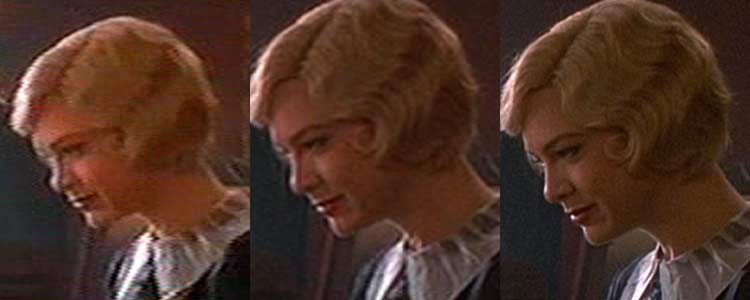
You should be able to see that the Blu-ray version shows some gentle film grain, but also has crisply defined edges, plenty of detail in her hair and a natural smoothness. The DVD by contrast has lost about half the hair detail, introduced an impression of ghosting around her nose, and even obscured quite prominent detail. Look, for example, at the highlights on her throat on the Blu-ray version, and what has happened to them on the DVD.
As for the VHS, there is no detail in the hair, it is not clear that there are any highlights on her throat at all, there is spurious noise all through the picture, and the jaggies on her collar attest to a slight field misalignment from the video player.
It is well known that the movie Director Stanley Kubrick had a soft spot for the old 1.37:1 Academy aspect ratio. So he is said to have filmed in anticipation of presentation in both a 4:3 frame, and in widescreen (which the studios would of course force on him for cinema display). Many of his movies were presented on DVD in full 4:3 frame format, not having been mutilated by a Pan and Scan process, but according to his wishes in order to show a fuller picture.
Full Metal Jacket was one such ... at least until it came to Blu-ray (see here for the original FMJ Blu-ray release compared with the DVD, and see here for the improved, remastered Blu-ray release compared with the first release). The VHS and DVD versions are both presented in 4:3 aspect ratio, but the Blu-ray versions are both presented as widescreen. Versions? Yes, Warner Bros released two. The first one attracted much criticism on picture quality grounds, so some months later it released a much better 'Deluxe Edition', which improved the colour balance, permitted some deep black to come into the picture, and added a great deal more detail. This one was presented in a full 16:9 frame, with significant cropping of the top and bottom of the picture. Here's the full Blu-ray frame to establish the scene:

To give a sense of the different aspect ratio layout used on the DVD and VHS, here's the former:

Note how you can see the soldier's left boot in the 4:3 version, and much more of the ceiling above his head, while losing nothing to the left or right of the frame. That's why the items within this detail, showing the machine gun in the three different formats, are quite different in size. Remember, left is VHS, centre is DVD, right is Blu-ray:
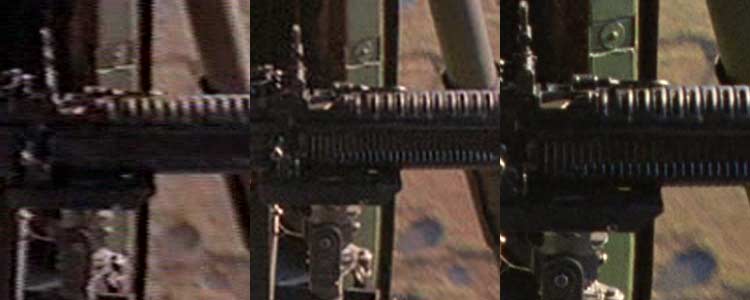
While the 'Deluxe Edition' Blu-ray is markedly better than the first version in all departments, it still won't win any awards for the sharpest possible picture. Nonetheless, the Blu-ray version is, if a bit soft, still reasonably detailed and looks quite natural. The DVD suffers mostly not through loss of detail, but through spurious picture noise which appears to be from the MPEG2 compression. But when it comes to the VHS, there's a little horizontal smearing along the scan lines, remarkable fuzziness and a near complete loss of detail on the underside of the machine gun.
I chose three different frames from the 1996 blockbuster Independence Day, primarily because this is a movie very close to reference quality on Blu-ray.
But it did present some difficulties. For more than half the movie a mastering error was made on the VHS version, with one of the fields contributing to any given frame drawn inappropriately from the next frame. That was largely unnoticable on a CRT TV, but could result in the loss of even more resolution on a progressive display. Here is a detail from one of the error-stricken frames, illustrating the clear inclusion of fields from two quite separate frames:

Interestingly, I actually first discovered this on the original Independence Day DVD. Even though they had different aspect ratios (widescreen for the DVD, 4:3 for the VHS), somehow the source must have had the same error. Eventually a new version of the 'Independence Day' DVD was issued without this problem, and it is this new version I used in this comparison.
As to the VHS, in order to do this comparison I used Photoshop to extract the matching fields from adjacent frames and wove them together to make frames the way that they were intended to be. In reality, in the first and third comparison shots below, the VHS would have looked even worse because a display would have had to use video-style deinterlacing. The second comparison frame was in a section of the video that didn't have this problem.
Now let us present the three establishing frames along with their details from the three formats. Here's the first full frame:
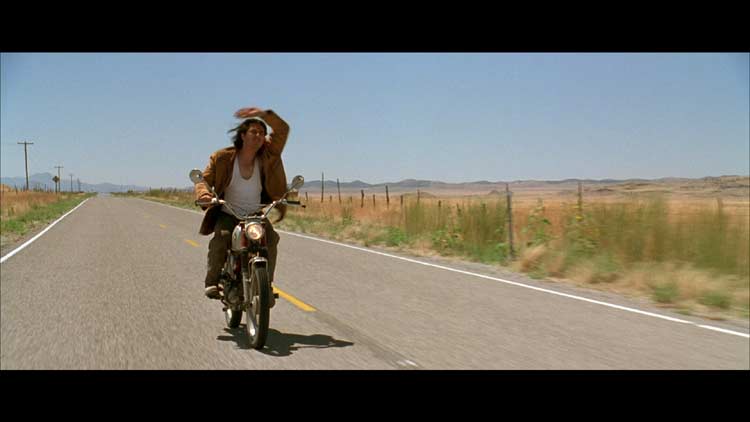
And here is a detail from the three different formats. Left is VHS, centre is DVD, right is Blu-ray:

Here James Duvall's character is trying to chase down his (remarkably unsimilar) father. Just how good the Blu-ray looks can be judged from just how bad the DVD looks. In the DVD, half of the creases of his jacket have gone, as has his chin and the narrow cross-bar between the motorcycle's handlebars. In the VHS version, things are far worse. Aside from the loss of even more detail, see the way the brown of the coat is gently bleeding yellow/brown into the sky to its right. And look at those stubby comb lines extended to the sides along the scanlines. Sloppy cut and paste by me when I was assembling the frame from the two fields? No, this was a misalignment between the fields, and even within them. You will notice that those comb lines are most clear on his arm and the bottom part of the coat, but a bit below his armpit they almost disappear. When I tried horizontally aligning the fields to eliminate the combs, all it did was make them appear elsewhere, such as the present relatively comb-free section. What that says is that field scanlines are uneven within the one field! You can never correct this.
The second full frame:
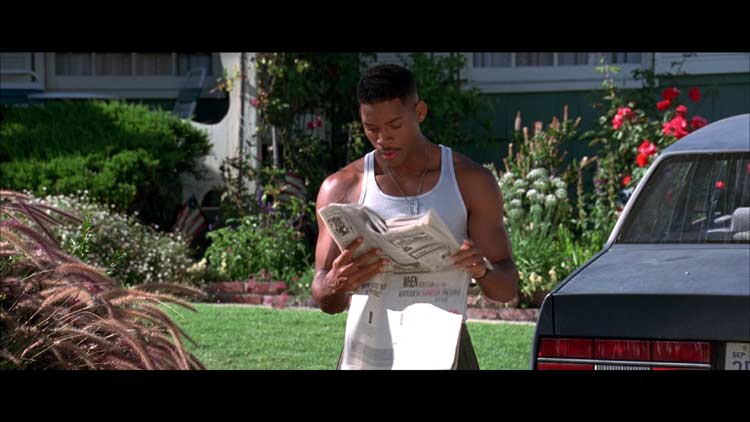
And Will Smith up close (left is VHS, centre is DVD, right is Blu-ray):
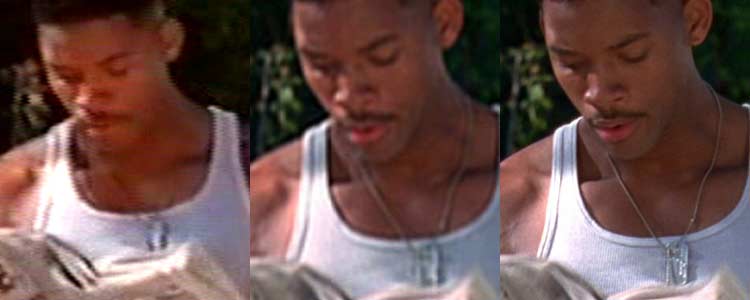
This frame is from a section of the movie where the field-to-frame error hadn't been made in the VHS copy in first place (likewise, this section was clear of the error on the first DVD release). Yet inspect the side of Will Smith's face and there are those clear jagged combs again. Now look at the Blu-ray. You can see Smith's lips pursed, and the texture of the material of his singlet. The impressed text on his dogtags seems just tantalisingly out of reach. With the DVD, there is no material texture, the dogtags are a fuzzy splodge, but at least you still see the pursed lips. As for the VHS, you might as well use your imagination if you're trying to determine what facial expression he is exhibiting.
And the third full frame, a night scene:

And a detail from this scene up close (left is VHS, centre is DVD, right is Blu-ray):
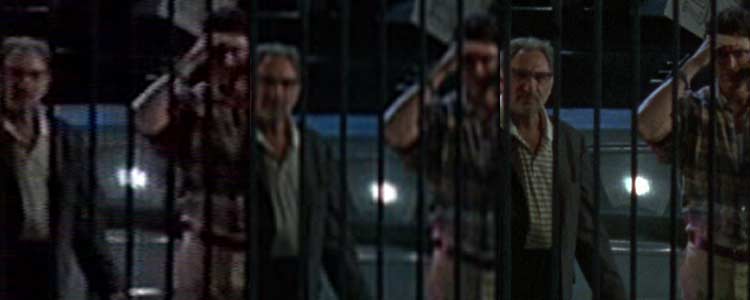
In this relatively dark scene the VHS doesn't seem to do quite so much combing damage, although a little is evident on Judd Hirsch's shirt front. What, you couldn't recognise Hirsch from the VHS shot, nor Jeff Goldblum next to him? Well, skip the better, but still very fuzzy, DVD version and look at the Blu-ray, which shows his glasses clearly along with the horizontal stripes of his shirt and the window trim of the car behind them.
Things have come a long way over the past 30-odd years in which home video has been a reality. Sometimes when I compare Blu-ray to DVD the Blu-ray improvement is marginal. As demonstrated by Full Metal Jacket, sometimes DVD resolution is almost sufficient to capture all the detail that would also be shown on Blu-ray, thanks to the limitations of the source.
But Blu-ray improved on DVD not just in resolution and detail. It also provides a smoother, more film-like result free of arbitrary noise.
And both Blu-ray and DVD though, smash VHS on every level of quality, quite aside from the issues concerning longevity and convenience.